Authors & editors
ANU Press has collaborated with a diverse range of authors and editors across a wide variety of academic disciplines. Browse the ANU Press collection by author or editor.
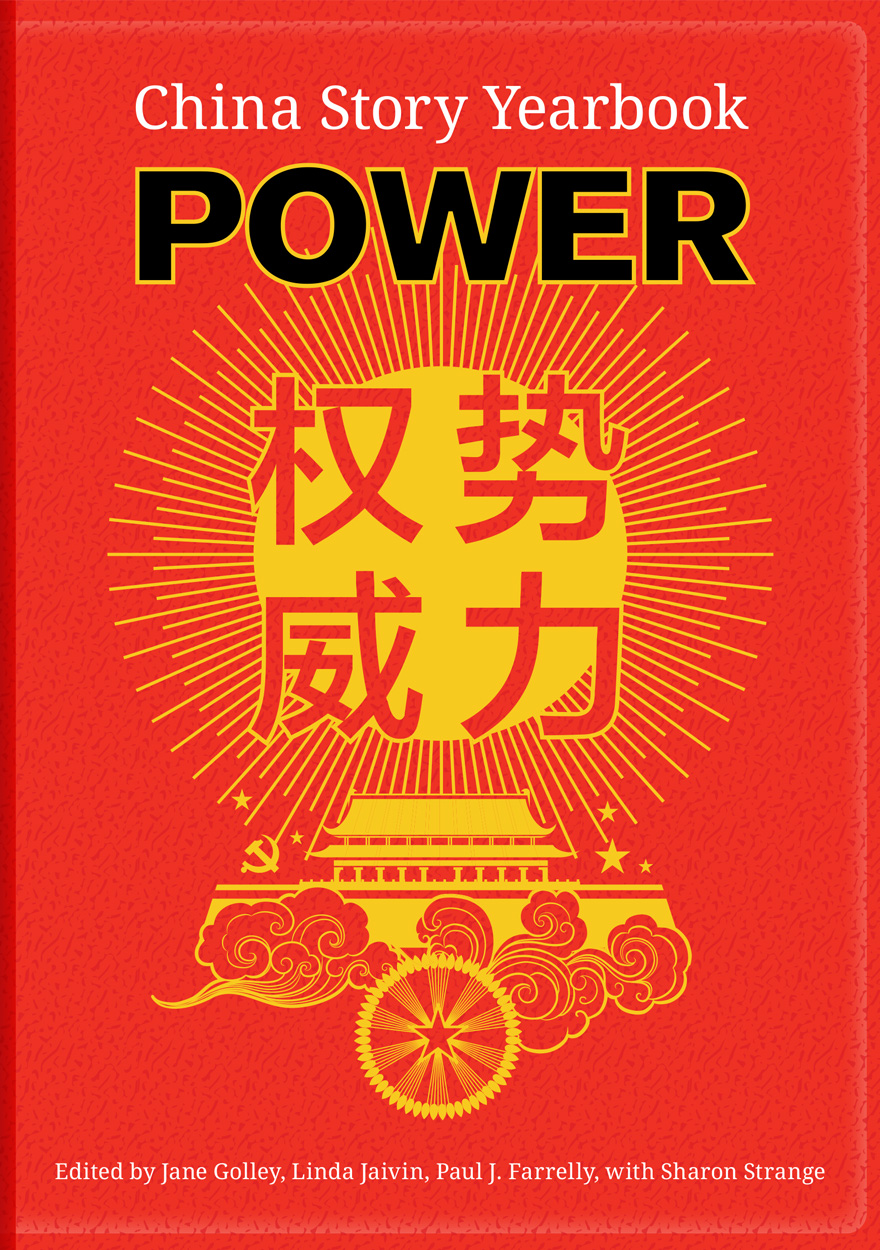
Power »
Edited by: Jane Golley, Linda Jaivin, Paul J. Farrelly, Sharon Strange
Publication date: April 2019
In 2018, the People’s Republic of China (PRC) was, by most measures, more powerful than at any other time in its history and had become one of the most powerful countries in the world. Its economy faced serious challenges, including from the ongoing ‘trade war’ with the US, but still ranked as the world’s second largest. Its Belt and Road Initiative, meanwhile, continued to carve paths of influence and economic integration across several continents. A deft combination of policy, investment, and entrepreneurship has also turned the PRC into a global ‘techno-power’. It aims, with a good chance of success, at becoming a global science and technology leader by 2049 – one hundred years from the founding of the PRC.
In surveying the various ways in which the Party-state wields its hard, soft, and sharp power, the China Story Yearbook: Power offers readers a sense of the diversity of power at work both in China and abroad. Citizens of the PRC have long negotiated the state’s influence; increasingly, diaspora communities and other actors are now being subject to its might. As with previous editions in the series, we place important developments in historical context, and adopt a cross-disciplinary approach: it is our view that economy and politics cannot be divorced from culture, history, and society. The Yearbook provides accessible analysis of the main events and trends of the year and is an essential tool for understanding China’s growing power and influence around the world.

In Search of the Never-Never »
Mickey Dewar: Champion of History Across Many Genres
Edited by: Ann McGrath
Publication date: April 2019
Mickey Dewar made a profound contribution to the history of the Northern Territory, which she performed across many genres. She produced high‑quality, memorable and multi-sensory histories, including the Cyclone Tracy exhibition at the Museum and Art Gallery of the Northern Territory and the reinterpretation of Fannie Bay Gaol. Informed by a great love of books, her passion for history was infectious. As well as offering three original chapters that appraise her work, this edited volume republishes her first book, In Search of the Never-Never. In Dewar’s comprehensive and incisive appraisal of the literature of the Northern Territory, she provides brilliant, often amusing insights into the ever-changing representations of a region that has featured so large in the Australian popular imagination.
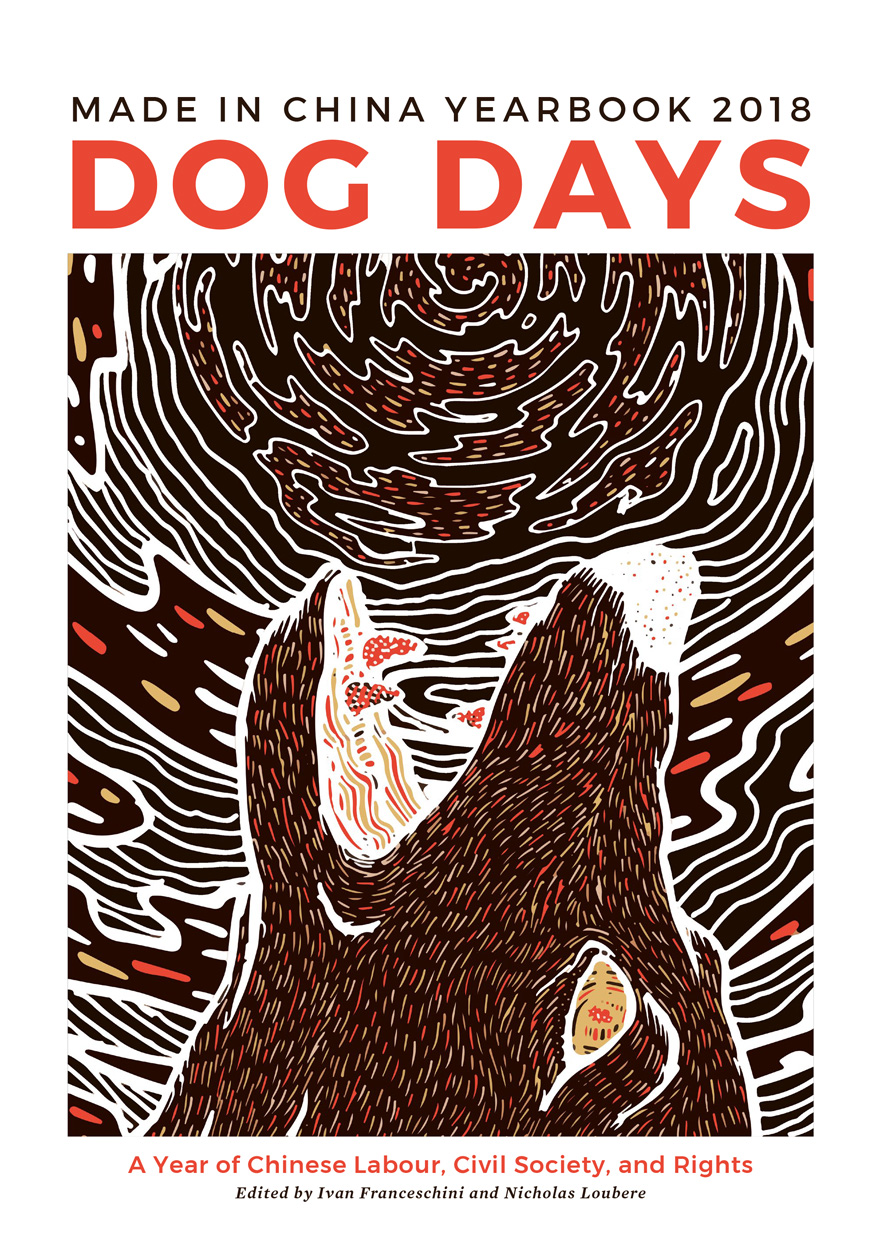
Dog Days »
Made in China Yearbook 2018
Edited by: Ivan Franceschini, Nicholas Loubere
Publication date: April 2019
According to the Chinese zodiac, 2018 was the year of the ‘earthly dog’. In the middle of the long, hot, and feverish dog days of the summer of 2018, some workers at Shenzhen Jasic Technology took their chances and attempted to form an independent union. While this action was met by the harshest repression, it also led to extraordinary demonstrations of solidarity from small groups of radical students from all over the country, which in turn were immediately and severely suppressed. China’s year of the dog was also imbued with the spirit of another canine, Cerberus—the three-headed hound of Hades—with the ravenous advance of the surveillance state and the increasing securitisation of Chinese society, starting from the northwestern region of Xinjiang. This Yearbook traces these latest developments in Chinese society through a collection of 50 original essays on labour, civil society, and human rights in China and beyond, penned by leading scholars and practitioners from around the world.

Also Innovators »
How one computer salesman contributed to the digital revolution
Authored by: Christopher B. Yardley
Publication date: April 2019
‘Thank you for your order, Mr Mainframe Customer. The cost is £5 million and the lead-time for manufacture will be two years. In the meantime you will have to build a special computer centre to our specification. For our part, our project team will help you recruit and train potential programmers and we shall advise on how you might use the system.’
How different from today when the customer will want to see a specific application running before he puts a hand in his/her pocket. Chris Yardley lived the changes as a computer salesman and tells his story of a career living and working in five countries. Warts and all. The ecstasies, the heartbreaks and idiocies of major corporations.
His career was not a planned one. In a growing industry, opportunities presented themselves and Chris believes he grasped every one presented. Having written his story, he has had every chapter verified by at least one person who features in that narrative. His respondents have universally endorsed the facts with comments such as ‘Wow, I’d forgotten most of that’. ‘You have a fantastic memory.’ ‘I never knew before the full facts of what happened.’ ‘How have you remembered all the circumstances?’ ‘It really is a people business.’
This is the only book that has followed a computer sales career over almost 50 years.

Made in China Journal: Volume 4, Issue 1, 2019 »
Edited by: Ivan Franceschini, Nicholas Loubere
Publication date: March 2019
Sun and moon have no light left, earth is dark; / Our women’s world is sunk so deep, who can help us? / Jewelry sold to pay this trip across the seas, Cut off from my family I leave my native land. / Unbinding my feet I clean out a thousand years of poison, / With heated heart arouse all women’s spirits. / Alas, this delicate kerchief here / Is half stained with blood, and half with tears.
— Qiu Jin, 1904 (translated by Jonathan Spence)
As she bode farewell to China in the summer of 1904, early revolutionary Qiu Jin penned these words to bemoan the fate of herself and of uncountable Chinese women. She was leaving behind her husband—whom she had married out of obligation—and two young children to go to study in Japan. Having returned to China, she would continue to engage in revolutionary activities, and was ultimately beheaded by the Qing authorities in July 1907 at the age of 31. Martyrdom made her into a legend. More than a century later, bound feet belong to another age and kerchieves stained with blood and tears have become an overused trope in revolutionary literature. Still, Qiu Jin’s spirit is more alive than ever in a whole new generation of Chinese feminists who are fighting for women’s rights—a renewed attempt to smash the bell jar of China’s patriarchal society. This issue of the Made in China Journal offers a series of perspectives on the plight and struggles of women and sexual minorities in today’s China.
Download for free
Not available for purchase

East Asia Forum Quarterly: Volume 11, Number 1, 2019 »
Publication date: March 2019
This issue of East Asia Forum Quarterly touches on key economic and social questions that affect gender equality in Southeast Asia and East Asia, delving beneath the aggregates and measurement challenges. Strengthening the evidence base is critical to building the policy toolkit and shaping public investments that ensure no woman or man is left behind.
East Asia Forum Quarterly grew out of East Asia Forum (EAF) online, which has developed a reputation for providing a platform for the best in Asian analysis, research and policy comment on the Asia Pacific region in world affairs. EAFQ aims to provide a further window onto research in the leading research institutes in Asia and to provide expert comment on current developments within the region. The East Asia Forum Quarterly, like East Asia Forum online, is an initiative of the East Asia Forum (EAF) and its host organisation, the East Asian Bureau of Economic Research (EABER) in the Crawford School of Economics and Government in the College of Asia & the Pacific at The Australian National University.
Download for free
Not available for purchase
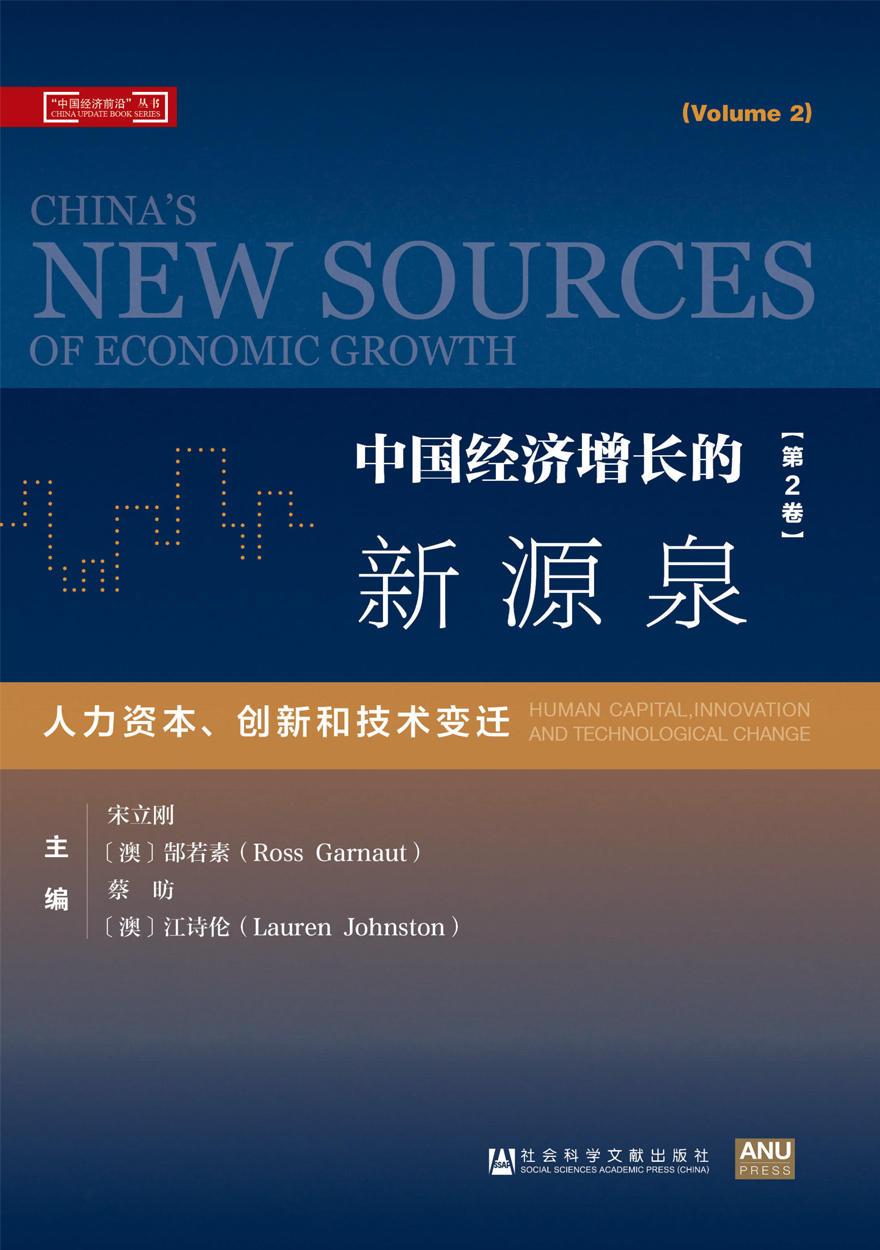
China's New Sources of Economic Growth: Vol. 2 (Chinese version) »
人力资本、创新和技术变迁
Edited by: 宋 立刚, Ross Garnaut, 蔡 昉, Lauren Johnston
Publication date: March 2019
本书试图对人力资本、创新和技术变迀在转型经济中的作用做深层次分析,并讨 论中国的经历在何种方式上为中国自身和其他国家提供了重要的经验教训。我们生活 在一个现代技术越来越多地影响着我们方方面面生活的全新时代。虽然中国正付出极 大努力通过增加人力资本和技术创新来完成经济结构调整和转型,但仍面临巨大的挑 战。为此,本书深入研究了人力资本、创新和技术变迀在影响中国经济增长模式和中 国经济总体发展格局中的作用,考察了宏观经济最新发展情况以及教育和创新发展的 趋势,还研究了结构变化是如何为中国获得一系列更先进增长驱动力做好准备的。
Chinese print version of this book is available from Social Science and Academic Press

A Doctor Across Borders »
Raphael Cilento and public health from empire to the United Nations
Authored by: Alexander Cameron-Smith
Publication date: February 2019
In his day, Raphael Cilento was one of the most prominent and controversial figures in Australian medicine. As a senior medical officer in the Commonwealth and Queensland governments, he was an active participant in public health reform during the inter-war years and is best known for his vocal engagement with public discourse on the relationship between hygiene, race and Australian nationhood. Yet Cilento’s work on tropical hygiene and social welfare ranged beyond Australia, especially when he served as a colonial medical officer in British Malaya and in the Mandated Territory of New Guinea. He also worked with the League of Nations Health Organization in the Pacific Islands and oversaw international social welfare programs for the United Nations. On one level, this professional mobility allowed ideas and practices of public health and government to circulate between colonial spaces of northern Australia, the Pacific Islands and Asia. On another, it meant that Cilento’s Pacific colonialism and colonial experience shaped his understanding of Australian national health and welfare. Rather than attempt a comprehensive biography of Cilento, this book instead uses this border-crossing career as a means to explore several material and discursive facets of Australia’s relationships to the Pacific and the world.

The Court as Archive »
Publication date: February 2019
Until the late 20th century, ‘an archive’ generally meant a repository for documents, as well as the generic name for the wide range of documents the repository might hold. An archive could be visited, and then also searched, to discover past actions or lives that had meaning for the present. While historians and historiographers have long understood the contests that archives contain and represent, the very idea of ‘the archive’ has, over the last 40 years, become the subject and object of widening and intensified consideration. This consideration has been intellectual (from scholars in a wide range of disciplines) and public (from communities and individuals whose stories are held captive, or sometimes hidden or excluded from official archives), as well as institutional. It has involved scrutiny and critique of official archives’ limitations and practices, as well as symbolic, affective and theoretical expansion and heightened expectation of what ‘the archive’ is or should be. The very language of ‘the archive’ now carries freight as administrative practice, normative value, metaphor, description and aspiration in different ways than it did in the 20th century.
This collection offers a unique contribution to these reinvigorated and sometimes new conversations about what an archive might be, what it can do as a consequence, and to whom it bears custodial responsibilities. In particular, this collection addresses what it means for contemporary Australian superior courts of record to not only have constitutional and procedural duties to documents as a matter of law, but also to acknowledge obligations to care for those materials in a way that understands their public meaning and public value for the Australian people, in the past, in the present and for the future.

Drawing in the Land »
Rock Art in the Upper Nepean, Sydney Basin, New South Wales
Authored by: Julie Dibden
Publication date: February 2019
Drawing in the Land offers an important contribution to the field of rock art research and Australian archaeology. It provides a detailed study of the previously under-examined rock art of the Hawkesbury/Nepean area of New South Wales. The study presents a detailed historiography of Australian rock art research and, through the lens of landscape archaeology, offers an innovative contribution to rock art studies in the wider Sydney Basin.
The volume’s theoretical focus on materiality, embodied practice and performance allows for the charting of ideational change and provides a unique contribution to the late Holocene archaeology of NSW and contact archaeology within Australia more broadly.

Made in China Journal: Volume 3, Issue 4, 2018 »
Edited by: Ivan Franceschini, Nicholas Loubere
Publication date: December 2018
In December 2018, the Chinese authorities commemorated the 40th anniversary of China’s reform and opening up. These four decades of unprecedented economic growth and transformation have been rooted in a fundamental socioeconomic restructuring. Contemporary China has changed from a largely agrarian society predominantly inhabited by peasants, to a rapidly urbanising one, characterised by a floating populace moving back and forth between rural and urban spaces, which are in a continuous state of flux. Going hand in hand with China’s ascent into modernity is the subordination of rural areas and people. While rural China has historically been a site of extraction and exploitation, in the post-reform period this has intensified, and rurality itself has become a problem. This issue of Made in China focuses on the labour that these attempts to restructure and reformulate rural China have entailed, and the ways in which they have transformed rural lives and communities.
Download for free
Not available for purchase
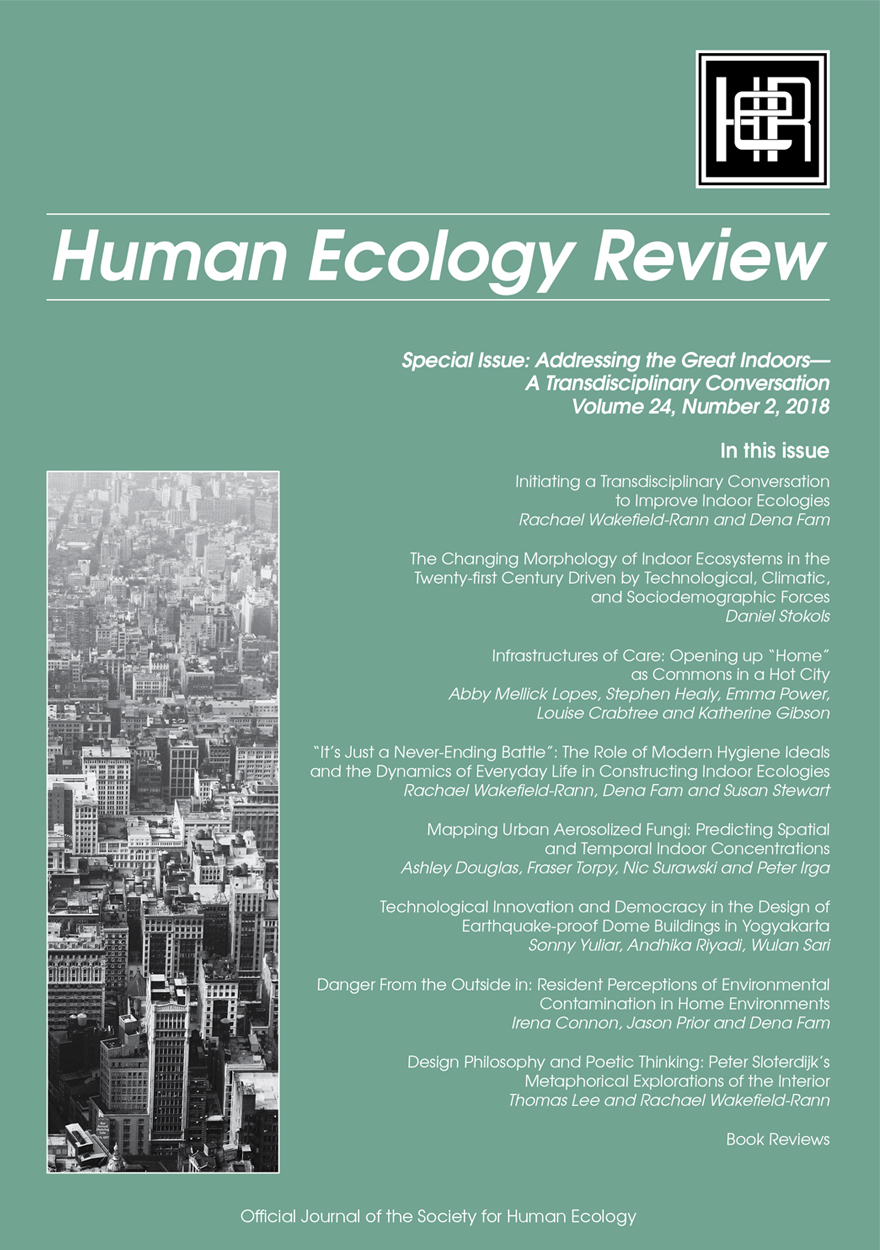
Human Ecology Review: Volume 24, Number 2 »
Special Issue: Addressing the Great Indoors — A Transdisciplinary Conversation
Publication date: December 2018
Human Ecology Review is a semi-annual journal that publishes peer-reviewed interdisciplinary research on all aspects of human–environment interactions (Research in Human Ecology). The journal also publishes essays, discussion papers, dialogue, and commentary on special topics relevant to human ecology (Human Ecology Forum), book reviews (Contemporary Human Ecology), and letters, announcements, and other items of interest (Human Ecology Bulletin). Human Ecology Review also publishes an occasional paper series in the Philosophy of Human Ecology and Social–Environmental Sustainability.
Download for free
Not available for purchase

Pacific Exposures »
Photography and the Australia–Japan Relationship
Authored by: Melissa Miles, Robin Gerster
Publication date: December 2018
Photography has been a key means by which Australians have sought to define their relationships with Japan. From the fascination with all things Japanese in the late nineteenth century, through the era of ‘White Australia’, the bitter enmity of the Pacific War, the path to reconciliation in the post-war period and the culturally complicated bilateralism of today, Australians have used their cameras to express a divided sense of conflict and kinship with a country that has by turns fascinated and infuriated. The remarkable photographs collected and discussed here for the first time shed new light on the history of Australia’s engagement with its most important regional partner. Pacific Exposures argues that photographs tell an important story of cultural production, response and reaction—not only about how Australians have pictured Japan over the decades, but how they see their own place in the Asia-Pacific.
‘Pacific Exposures presents the first study of the photographic exchanges between Australia and Japan—its photographers, personalities, motivations, anxieties and tensions—based on a diverse range of archival materials, interviews, and well-chosen photographs.’
— Dr Luke Gartlan, University of St Andrews
‘[Pacific Exposures] will become a key text on Australia’s interactions with Japan, and the way that photographs can inform cross-cultural relations through their production, consumption and circulation.’
— Prof. Kate Darian-Smith, University of Tasmania
In the media
Listen to the ABC Radio interview: Japan in Focus (from 13:06).

Global Debates, Local Dilemmas »
Sex-selective Abortion in Contemporary Viet Nam
Authored by: Tran Minh Hang
Publication date: December 2018
The practice of sex-selective abortion is on the rise globally, stirring debates about gender inequality, medical ethics and reproductive autonomy. This book is the first ethnography to document practices of sex selection in Viet Nam. It shows how and why abortions are used to select the sex of children and how Vietnamese individuals and health professionals are implicated in this illicit and controversial practice. Telling the stories of women who have undergone sex-selective abortions, it traces their passage through sex determination and abortion decision-making phases, and investigates their experiences during and after their sex-selective abortions. It describes the turmoil experienced by individuals who undergo such abortions and explores their interactions with the spectrum of social actors and health institutions that facilitate practices of sex selection.
As the first ethnographic study on sex-selective abortions in Viet Nam, this book delves into socially sensitive terrain and sheds light on personally fraught individual experiences of reproductive agency. It documents societal responses to sex-selective abortions in Viet Nam and identifies gaps in the state’s capacity to regulate reproductive desire in a marketised economy. A resource for researchers, it contributes to ongoing debates on sex selection and provides a framework for developing relevant social policies, interventions and support services.
‘This pioneering study offers a nuanced and sensitive account of sex-selective abortion as human experience. Through thought provoking case studies, the book provides rare ethnographic documentation of the complex quandaries that arise as selective reproductive technologies are routinised across the globe.’
— Tine M. Gammeltoft, Department of Anthropology, University of Copenhagen

Aboriginal History Journal: Volume 42 »
Edited by: Ingereth Macfarlane
Publication date: December 2018
In this volume, Peter Sutton provides a survey of the articles published by linguist Dr Luise Hercus (1926–2018) in Aboriginal History, honouring the contribution she has made to the journal since its inception. The seven articles this year highlight the wealth of sources that feed into historical research of Indigenous Australia. The role of performance in the events organised by the National Aborigines Day Observance Committee (NADOC) in 1957–67 in Sydney shows up the contest between state assimilationist goals and Indigenous participants’ insistence on distinction, continuity and survival (Jonathon Bollen and Anne Brewster). The then radical agenda – in a protectionist policy regime – of the advocacy group, the Aborigines’ Protection League in South Australia in the 1920s–30s, is examined in a detailed study of the group’s campaigns and campaigners (Rob Foster). A picture of colonial reception of Aboriginal performance and the public assertion of local Aboriginal cultural priorities in 1893 Darwin is developed in the historical contextualisation of a collection of Aboriginal artefacts found in the Marischal Museum, Aberdeen (Gaye Sculthorpe). A nuanced analysis of the relationship between the Catholic Benedictine Mission at New Norcia and the Western Australian Native Welfare Department draws on the correspondence between the Abbot of New Norcia and A.O. Neville (Elicia Taylor). A large body of reader responses to a recent online article on the deep history of Aboriginal Australia provides a way to map the strengths and weaknesses in the general Australian public’s apprehension of that long history (Lynette Russell and Billy Griffiths). A spatial history argues against the concept of ‘fringe camps’ and for a pattern of demonstrable continuities between precolonial, colonial and recent Aboriginal people’s favoured camp places and the locations of urban contemporary park spaces in Brisbane and townships in south-eastern Queensland (Ray Kerkhove). In the format of an interview, the themes concerning the writing of Aboriginal history and contemporary political debates that are developed in Tim Rowse’s recent book Indigenous and Other Australians since 1901 (2017) are explored (Miranda Johnson and Tim Rowse).
Aboriginal History Inc. is a publishing organisation based in the Australian Centre for Indigenous History, Research School of Social Sciences, The Australian National University, Canberra.
For more information on Aboriginal History Inc. please visit aboriginalhistory.org.au.
Download for free
Not available for purchase
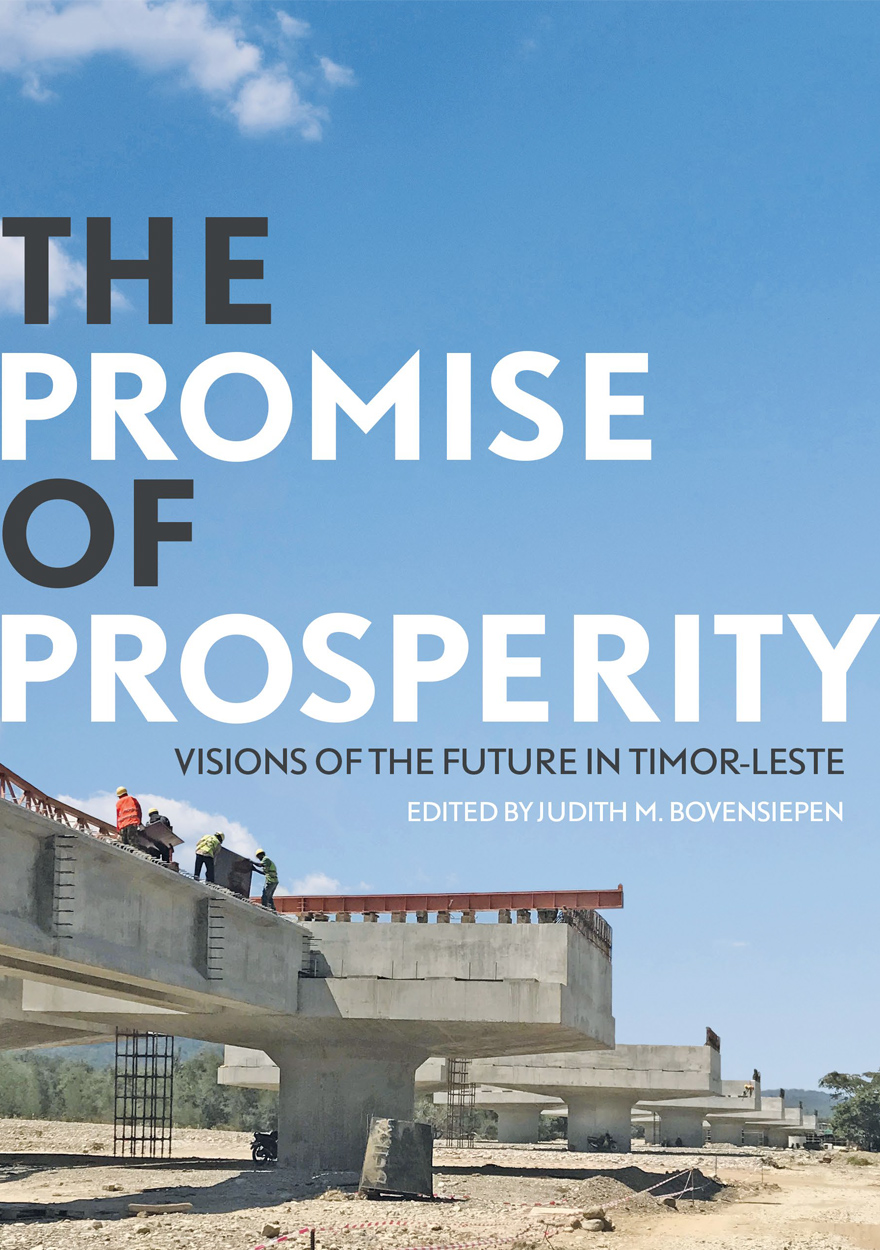
The Promise of Prosperity »
Visions of the Future in Timor-Leste
Edited by: Judith Bovensiepen
Publication date: December 2018
For the people of Timor-Leste, independence promised a fundamental transformation from foreign occupation to self-rule, from brutality to respect for basic rights, and from poverty to prosperity. In the eyes of the country’s political leaders, revenue from the country’s oil and gas reserves is the means by which that transformation could be effected. Over the past decade, they have formulated ambitious plans for state-led development projects and rapid economic growth. Paradoxically, these modernist visions are simultaneously informed by and contradict ideas stemming from custom, religion, accountability and responsibility to future generations. This book explores how the promise of prosperity informs policy and how policy debates shape expectations about the future in one of the world’s newest and poorest nation-states.

Indigenous Efflorescence »
Beyond Revitalisation in Sapmi and Ainu Mosir
Publication date: December 2018
Indigenous efflorescence refers to the surprising economic prosperity, demographic increase and cultural renaissance currently found amongst many Indigenous communities around the world. This book moves beyond a more familiar focus on ‘revitalisation’ to situate these developments within their broader political and economic contexts. The materials in this volume also examine the everyday practices and subjectivities of Indigenous efflorescence and how these exist in tension with ongoing colonisation of Indigenous lands, and the destabilising impacts of global neoliberal capitalism. Contributions to this volume include both research articles and shorter case studies, and are drawn from amongst the Ainu and Sami (Saami/Sámi) peoples (in Ainu Mosir in northern Japan, and Sapmi in northern Europe, respectively). This volume will be of use to scholars working on contemporary Indigenous issues, as well as to Indigenous peoples engaged in linguistic and cultural revitalisation, and other aspects of Indigenous efflorescence.

Introduction to the Tibetan Language »
An eTextbook for spoken and literary Tibetan
Publication date: December 2018
This textbook includes twelve multi-media introductory lessons for Tibetan learners. There are sections that explain how to write and read the Tibetan alphabet, how to write and read Tibetan words, and easy colloquial and literary sentences. Each section includes a dialogue that is performed in videos and written down, written explanations of different aspects of the language, videos that demonstrate how to write, read and pronounce Tibetan, and exercises that will help solidify what you have learned. The book also includes links to online sources, including flashcards to aid vocabulary building.
Part 1 is an introduction to reading and writing Tibetan.
Part 2 builds on these skills and helps Tibetan learners develop conversational skills.
Part 3 introduces literary Tibetan by building on the commonalities between it and conversational Tibetan.
Here is everything you need to learn the world's highest language.
This textbook is used as course material in:
Tibetan 1 TIBN1002
Tibetan 2 TIBN1003
For more information about studying a language at the ANU, please visit the College of Asia and the Pacific Languages website and take a look at the School of Culture, History and Language’s Language Guide (PDF, 2.2 MB).
Download for free
Not available for purchase
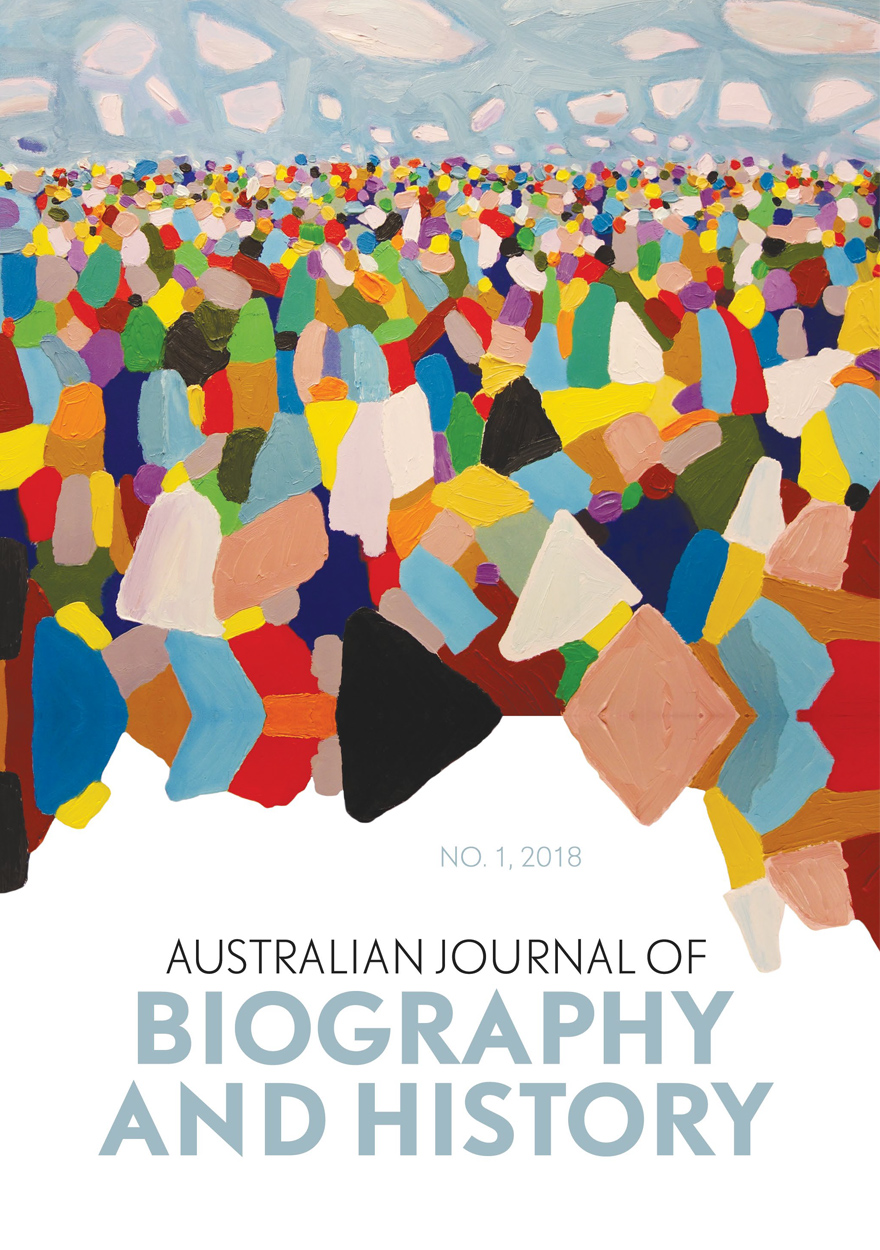
Australian Journal of Biography and History: No. 1, 2018 »
Publication date: December 2018
In this first issue, a diverse range of essays primarily relates to questions of individuals and the contexts in which they functioned, the ‘middle ground’ between a life and the times. Four of them concern Australian women who operated and negotiated various fields of endeavour, only one of which—the role of headmistress of a girls’ school—was unambiguously a woman’s domain. The profile of Miss Annie Hughston (1859–1943) shows how a strong figure could have a disproportionate influence on women entering male bastions. Similarly, Nancy Atkinson, a pioneering bacteriologist at the University of Adelaide, was not only a scientific researcher of note but a teacher of generations of graduate students. Yet when the chair in her field finally became available, she was overlooked in favour of a male English import, despite having acted in the role for many years. She was valued it seems more for her teaching than her research, a classic tendency to ascribe to women in scientific circles a nurturing rather than a knowledge-creating function. Jean Andruana Jimmy (1912–1991), a Yupngayth woman from Mapoon in north Queensland, also became prominent in community leadership and land rights activism, areas that had been assumed to be male spheres. Yet leading her community was by no means as revolutionary as was often assumed by outside European observers, for Andruana saw herself resuming a role that was entirely consistent with women’s responsibilities. Sophie Scott-Brown’s portrait of the playwright and director Eunice Hangar examines the nature of reading as ‘a simultaneously social and individualistic activity’ and its implications for understanding the way Australians have read English writers.
The article on the nineteenth-century journalist and gold commissioner Fredrick Dalton explores the potential of nineteenth-century mobilities in the formation of identity. Karen Fox explores how family history, in this case the Stephen and Street ‘legal dynasty’, can illuminate an understanding of legal and power relations in a geographic setting. The article on André Kostermans, a renowned Dutch Indonesian botanist, is also on one level a story of shifting identity. Born in the Dutch East Indies, and trained in botany in Holland, Kostermans was interned by the Japanese during World War II, and used his skills to supplement the diet of his fellow prisoners of war, and to develop a ‘bush’ procedure for producing surgical-grade alcohol, actions that undoubtedly saved the lives of many. After the war, his career was almost ruined by the Indonesian government’s response to his homosexuality. In the final essay, the University of Xian scholar Tiping Su discusses the problem of the ‘missing’ Chinese in the Australian Dictionary of Biography, explaining the various issues in identifying and historicising the many Chinese who sojourned in Australia, as well as those who stayed.
Download for free
Not available for purchase
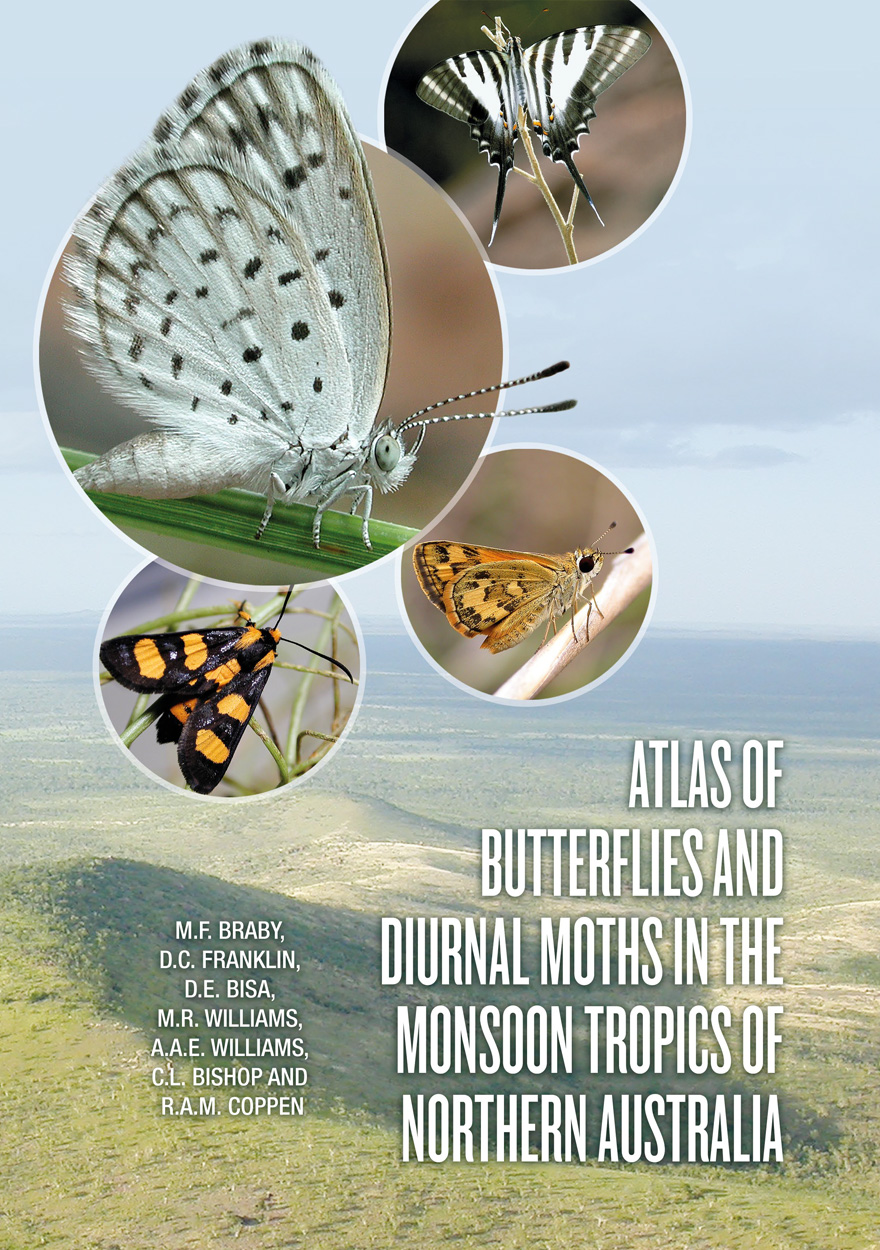
Atlas of Butterflies and Diurnal Moths in the Monsoon Tropics of Northern Australia »
Authored by: M.F. Braby, D.C. Franklin, D.E. Bisa, M.R. Williams, A.A.E. Williams, C.L. Bishop, R.A.M. Coppen
Publication date: December 2018
Northern Australia is one of few tropical places left on Earth in which biodiversity—and the ecological processes underpinning that biodiversity—is still relatively intact. However, scientific knowledge of that biodiversity is still in its infancy and the region remains a frontier for biological discovery. The butterfly and diurnal moth assemblages of the area, and their intimate associations with vascular plants (and sometimes ants), exemplify these points.
However, the opportunity to fill knowledge gaps is quickly closing: proposals for substantial development and exploitation of Australia’s north will inevitably repeat the ecological devastation that has occurred in temperate southern Australia—loss of species, loss of ecological communities, fragmentation of populations, disruption of healthy ecosystem function and so on—all of which will diminish the value of the natural heritage of the region before it is fully understood and appreciated. Written by several experts in the field, the main purpose of this atlas is to compile a comprehensive inventory of the butterflies and diurnal moths of northern Australia to form the scientific baseline against which the extent and direction of change can be assessed in the future. Such information will also assist in identifying the region’s biological assets, to inform policy and management agencies and to set priorities for biodiversity conservation.
In the media
Read the IFL Science article: Incredible Butterfly And Moth Diversity Hotspot Discovered In Northern Australia.
Read the Fairfax article: Butterfly 'detective' solves 120-year-old north Australian mystery.

The Lives of Stories »
Three Aboriginal-Settler Friendships
Authored by: Emma Dortins
Publication date: December 2018
The Lives of Stories traces three stories of Aboriginal–settler friendships that intersect with the ways in which Australians remember founding national stories, build narratives for cultural revival, and work on reconciliation and self-determination. These three stories, which are still being told with creativity and commitment by storytellers today, are the story of James Morrill’s adoption by Birri-Gubba people and re-adoption 17 years later into the new colony of Queensland, the story of Bennelong and his relationship with Governor Phillip and the Sydney colonists, and the story of friendship between Wiradjuri leader Windradyne and the Suttor family. Each is an intimate story about people involved in relationships of goodwill, care, adoptive kinship and mutual learning across cultures, and the strains of maintaining or relinquishing these bonds as they took part in the larger events that signified the colonisation of Aboriginal lands by the British. Each is a story in which cross-cultural understanding and misunderstanding are deeply embedded, and in which the act of storytelling itself has always been an engagement in cross-cultural relations. The Lives of Stories reflects on the nature of story as part of our cultural inheritance, and seeks to engage the reader in becoming more conscious of our own effect as history-makers as we retell old stories with new meanings in the present, and pass them on to new generations.

The Archaeology of Sulawesi »
Current Research on the Pleistocene to the Historic Period
Publication date: November 2018
The central Indonesian island of Sulawesi has recently been hitting headlines with respect to its archaeology. It contains some of the oldest directly dated rock art in the world, and some of the oldest evidence for a hominin presence beyond the southeastern limits of the Ice Age Asian continent. In this volume, scholars from Indonesia and Australia come together to present their research findings and views on a broad range of topics. From early periods, these include observations on Ice Age climate, life in caves and open sites, rock art, and the animals that humans exploited and lived alongside. The archaeology presented from later periods covers the rise of the Bugis kingdom, Chinese trade ceramics, and a range of site-based and regional topics from the Neolithic through to the arrival of Islam. This carefully edited volume is the first to be devoted entirely to the archaeology of the island of Sulawesi, and it lays down a baseline for significant future research.
Peter Bellwood
Emeritus Professor
The Australian National University
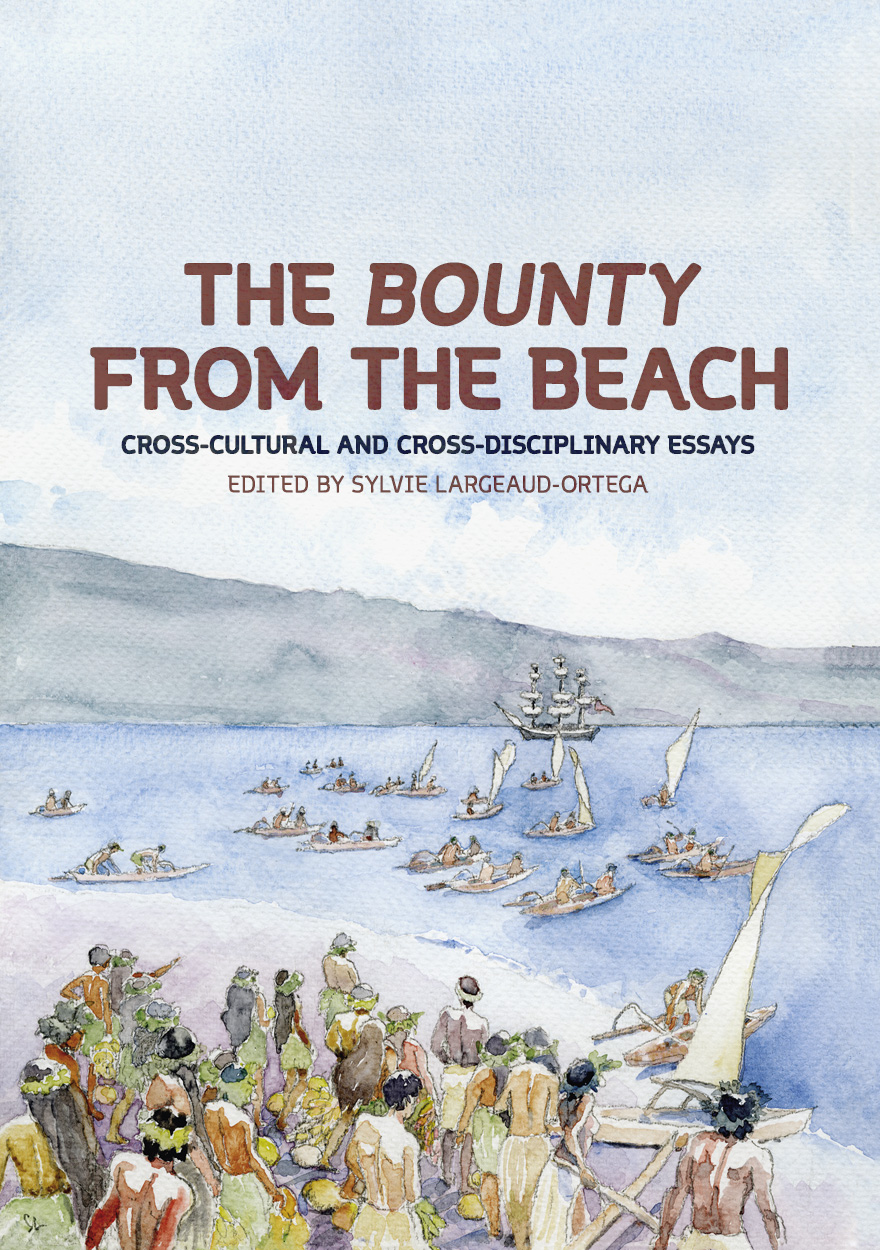
The Bounty from the Beach »
Cross-Cultural and Cross-Disciplinary Essays
Edited by: Sylvie Largeaud-Ortega
Publication date: October 2018
The Bounty from the Beach is a collection of cross-disciplinary essays, capitalising on a widely shared fascination for the Bounty story in order to draw scholarly attention to Oceania. It aims to reorient the Bounty focus away from the West, where most Bounty narratives and studies have emerged, to the Pacific, where most of the original events unfolded. It investigates the Bounty heritage from the standpoint of the beach, Greg Dening’s metaphor for culture contact and conflict in the Pacific Islands: this liminal place that transforms Islanders and voyagers, islands and ships, each time it is crossed. It analyses the way newcomers create new islands, and how these changes may occasionally impact the world. This volume examines the ‘little people’, to use another of Dening’s expressions, who stand ‘on both sides of the beach’: they are Polynesian or European or, as beaches are crossed and remade, no longer one without the other, but bound together in processes of change. Among these people are Bounty sailors, beachcombers, Pitcairners and indigenous Pacific Islanders of the past and the present.
This collection also explores the works of some renowned Western writers and actors who, turning mutineers after their own fashion and in their own times, themselves crossed the beach and attempted to illuminate the ‘little people’ involved in the Bounty narratives. These prominent writers and actors put the spotlight on characters who were silenced on account of race, class or geographical distance from the dominant centres of power. Inspired by Dening’s empowering voice, our purpose is to fill that silence.
Just as it criss-crosses the ocean, progressing with the ship through time and space, The Bounty from the Beach ranges far and wide across disciplines, methodologies and scholarly styles. Its multidisciplinary course contributes to illuminate the multiple ways in which the Bounty heritage embraces diverse horizons. It throws light on the colonial discourse that undertook to stifle Pacific Islander agency, and the neocolonial policies that have been applied to Oceania, and still are: hegemonic moves that have led to global environmental, nuclear and ecological hazards. As a whole, the collection contends that what unfolds in this vast ocean matters: the stakes are high for the whole human community.

Making Copyright Work for the Asian Pacific »
Juxtaposing Harmonisation with Flexibility
Edited by: Susan Corbett, Jessica Lai
Publication date: October 2018
This book provides a contemporary overview of developing areas of copyright law in the Asian Pacific region. While noting the tendency towards harmonisation through free trade agreements, the book takes the perspective that there is a significant amount of potential for the nations of the Asian Pacific region to work together, find common ground and shift international bargaining power. Moreover, in so doing, the region can tailor any regional agreements to suit local needs. The book addresses the development of norms in the region and the ways in which this can occur in light of the specific nature of the creator–owner–user paradigm in the region and the common interests of Indigenous peoples.

A New Rival State? »
Australia in Tsarist Diplomatic Communications
Publication date: October 2018
A New Rival State? is a unique collection of dispatches written in 1857–1917 by the Russian consuls in Melbourne to the Imperial Russian Embassy in London and the Russian Foreign Ministry in St Petersburg. Written by eight consuls, they offer a Russian view of the development of the settler colonies in the late nineteenth century and the first years of the federated Commonwealth of Australia. They cover the federalist movement, the changing domestic political situation, labour politics, the treatment of the Indigenous population, the ‘White Australia’ policy, Australia’s defensive capacity and foreign policy as part of the British Empire.
The bulk of the material is drawn from the Russian-language collection The Russian Consular Service in Australia 1857–1917, edited by Alexander Massov and Marina Pollard (2014), using documents from the archive of the Russian Foreign Ministry.



